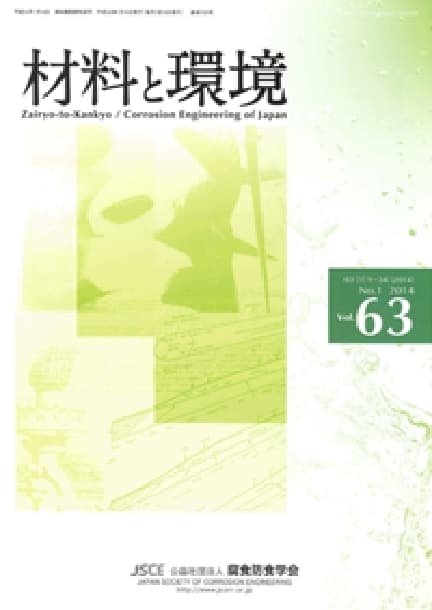- TOP
- Zairyo-to-Kankyo
- Vol. 64 (2015), No. 8
Zairyo-to-Kankyo Vol. 64 (2015), No. 8
Backnumber
-
Vol. 74 (2025)
-
Vol. 73 (2024)
-
Vol. 72 (2023)
-
Vol. 71 (2022)
-
Vol. 70 (2021)
-
Vol. 69 (2020)
-
Vol. 68 (2019)
-
Vol. 67 (2018)
-
Vol. 66 (2017)
-
Vol. 65 (2016)
-
Vol. 64 (2015)
-
Vol. 63 (2014)
-
Vol. 62 (2013)
-
Vol. 61 (2012)
-
Vol. 60 (2011)
-
Vol. 59 (2010)
-
Vol. 58 (2009)
-
Vol. 57 (2008)
-
Vol. 56 (2007)
-
Vol. 55 (2006)
-
Vol. 54 (2005)
-
Vol. 53 (2004)
-
Vol. 52 (2003)
-
Vol. 51 (2002)
-
Vol. 50 (2001)
-
Vol. 49 (2000)
-
Vol. 48 (1999)
-
Vol. 47 (1998)
-
Vol. 46 (1997)
-
Vol. 45 (1996)
-
Vol. 44 (1995)
-
Vol. 43 (1994)
-
Vol. 42 (1993)
-
Vol. 41 (1992)
-
Vol. 40 (1991)
Keyword Ranking
21 Dec. (Last 30 Days)
Zairyo-to-Kankyo Vol. 64 (2015), No. 8
Present Status of Various Analytical Techniques for Characterizing the Composition and Structure of Material Surfaces
Shigeru Suzuki
pp. 342-347
DOI:
10.3323/jcorr.64.342Abstract
Advanced surface analytical methods are outlined, and they are used to obtain new information on the surface phenomena of materials surfaces. For instance, angle-resolved X-ray photoelectron spectroscopy is used for analyzing the surface segregation of chromium and nitrogen on stainless steels and the native oxidation of their surfaces. X-ray absorption spectroscopy using synchrotron radiation is utilized for analyzing the chemical state and local structure of Fe in green rust.
In Situ Observation Techniques of Protective Oxide Layer
Takashi Doi, Takeharu Adachi, Noriaki Usuki
pp. 348-352
DOI:
10.3323/jcorr.64.348Abstract
In situ analyzing techniques for investigating a surface and interface change during corrosion and oxidation of metals by using Raman scattering spectroscopy (Raman), X-ray diffraction (XRD) and X-ray photoemission spectroscopy (XPS) are present. The Raman spectra revealed that a crystal structure and distribution of corrosion products varied during corrosion progress at elevated temperature and high pressure electrolyte. Time dependent XRD measurments made clear the behavior of the electrochemical reduction of a rust and the iso thermal transformation of a scale on a steel. It was demonstrated that XPS was capable of the in-situ measurments for initial stage of high temperature oxidation.
Corrosion Behavior inside Crevice of Stainless Steels under Cyclic Corrosion Test
Nobuhiko Hiraide, Shunji Sakamoto, Haruhiko Kajimura
pp. 358-365
DOI:
10.3323/jcorr.64.358Abstract
Cyclic corrosion tests, consisting of NaCl solution spraying, drying, and wetting process, were conducted using a crevice-structured spot-weld specimen of SUS436L in order to clarify the relation between corrosion behavior and amount of chloride accumulated into the crevice. The main component of chlorides accumulated into the crevice was sodium chloride coming from sprayed NaCl solution, although far less amount of metallic chlorides was also contained. The chloride content in the crevice depended on the concentration of spraying NaCl solution. When the concentration of spraying NaCl solution was 0.86 kmol・m-3, the amount of chloride reached about 20 mmol・m-2 and the maximum corrosion depth in the crevice increased as cycle number increased. When the amount of chloride reached about 20 mmol・m-2, the total amount of iron and chromium ions reached about 0.5 mmol・m-2 in the crevice. It is considered that pH in the crevice reached under depassivation pH of SUS436L, when the total amount of iron and chromium ions were 0.5 mmol・m-2. It is necessary that chloride which contains specific amount of metallic chlorides accumulate into the crevice for corrosion to proceed in the depth direction.
Readers Who Read This Article Also Read
Zairyo-to-Kankyo Vol.64(2015), No.1
Zairyo-to-Kankyo Vol.64(2015), No.5
Dissolution Behavior of Duplex Stainless Steels in Crevice Corrosion Growth Step
So Aoki, Yushi Nada, Jun'ichi Sakai
pp. 366-372
DOI:
10.3323/jcorr.64.366Abstract
The objective of this study is to clarify dissolution behavior of duplex stainless steels in crevice corrosion growth step. Crevice corrosion grew on the duplex stainless steels by holding potential at various values. After a certain period, dissolution behavior of the crevice corrosion was analyzed based on observation of corroded area. Change in crevice corrosion dissolution behavior with time was also investigated by means of in-situ observation. Four types of dissolution regions could be observed in the corrosion area from outside toward inside direction, i.e., tip of the corroded area toward initiation point, in a crevice; they were passive region, the preferential dissolution region of γ phase, α phase and γ phase dissolution region, and the preferential dissolution region of α phase. The crevice corrosion which maintained that four dissolution regions grew toward the edge of the crevice. This dissolution behavior was given at all the potential where crevice corrosion occurred.
Article Access Ranking
21 Dec. (Last 30 Days)
-
Delayed Fracture Mechanism of 1700 MPa-Class Quenched and Tempered Bolt under Atmospheric Corrosion Environment
Tetsu-to-Hagané Advance Publication
-
Perspectives on the Promising Pathways to Zero Carbon Emissions in the Steel Industry toward 2050
ISIJ International Vol.65(2025), No.2
-
Effect of B on Surface Oxidation Behavior and Phosphatability of Si-Mn-added Cold-Rolled Steel Sheets
ISIJ International Advance Publication
-
Factors Influencing the Bonding Phase Structure of Iron Ore Sinters
ISIJ International Vol.43(2003), No.9
-
Effect of microstructural heterogeneity on fatigue limit of as-quenched low-carbon low-alloy martensitic steel
ISIJ International Advance Publication
-
Prussian blue as a fully reversible hydrogenochromic material for visualizing hydrogen distribution in Fe sheet
ISIJ International Advance Publication
-
Metallurgical Aspects on Interstitial Free Sheet Steel From Industrial Viewpoints
ISIJ International Vol.34(1994), No.1
-
Influence of Antimony on the Oxidation Characteristics of 65Mn Steel
ISIJ International Advance Publication
-
From plasticity to fracture in pearlitic microstructures: Atomistic study of cementite thickness and deformation localization
ISIJ International Advance Publication
-
Growth, Removal, and Agglomeration of Various Type of Oxide Inclusions in Molten Steel
ISIJ International Advance Publication
You can use this feature after you logged into the site.
Please click the button below.










